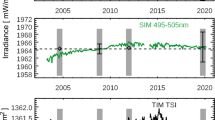Abstract
We compare total solar irradiance (TSI) and ultraviolet (F uv) irradiance variation reconstructed using Ca K facular areas since 1915, with previous values based on less direct proxies. Our annual means for 1925 – 1945 reach values 30 – 50 % higher than those presently used in IPCC climate studies. A high facula/sunspot area ratio in spot cycles 16 and 17 seems to be responsible. New evidence from solar photometry increases the likelihood of greater seventeenth century solar dimming than expected from the disappearance of magnetic active regions alone. But the large additional brightening in the early twentieth century claimed from some recent models requires complete disappearance of the magnetic network. The network is clearly visible in Ca K spectroheliograms obtained since the 1890s, so these models cannot be correct. Changes in photospheric effective temperature invoked in other models would be powerfully damped by the thermal inertia of the convection zone. Thus, there is presently no support for twentieth century irradiance variation besides that arising from active regions. The mid-twentieth century irradiance peak arising from these active regions extends 20 years beyond the early 1940s peak in global temperature. This failure of correlation, together with the low amplitude of TSI variation and the relatively weak effect of Fuv driving on tropospheric temperature, limits the role of solar irradiance variation in twentieth century global warming.






Similar content being viewed by others
References
Beer, J., Tobias, S., Weiss, N.: 1998, Solar Phys. 181, 237.
Bertello, L., Ulrich, R., Boyden, J.: 2010, Solar Phys. 264, 31.
Brown, G., Evans, D.: 1980, Solar Phys. 66, 233.
Camp, C., Tung, K.: 2007, Geophys. Res. Lett. 34, 14703.
Chapman, G., McGuire, T.: 1977, Astrophys. J. 217, 657.
Crowley, T.: 2000, Science 289, 270.
Eddy, J.: 1976, Science 192, 1189.
Ermolli, I., Solanki, S., Tlatov, A., Krivova, N., Ulrich, R., Singh, J.: 2009, Astrophys. J. 698, 1000.
Foukal, P.: 1996, Geophys. Res. Lett. 23, 2169.
Foukal, P.: 1998a, Astrophys. J. 500, 958.
Foukal, P.: 1998b, Geophys. Res. Lett. 25, 2909.
Foukal, P.: 2002, Geophys. Res. Lett. 29, 2089.
Foukal, P., Bernasconi, P., Fröhlich, C.: 2009, Bull. Am. Astron. Soc. 41, 827.
Foukal, P., Bertello, L., Livingston, W., Pevtsov, A., Singh, J., Tlatov, A., Ulrich, R.: 2009, Solar Phys. 255, 229.
Foukal, P., Chulsky, G., Weisenstein, D.: 2008, AGU Spring Meeting SP 53B-06.
Foukal, P., Fröhlich, C., Spruit, H., Wigley, T.: 2006, Nature 443, 161.
Foukal, P., Lean, J.: 1988, Astrophys. J. 328, 347.
Foukal, P., Lean, J.: 1990, Science 247, 505.
Foukal, P., Milano, L.: 2001, Geophys. Res. Lett. 28, 883.
Foukal, P., Ortiz, A., Schnerr, R.: 2011, Astrophys. J. Lett. 733, L38.
Fröhlich, C.: 2009, Astron. Astrophys. 501, L27.
Fröhlich, C.: 2011, Contrib. Astron. Obs. Skaln. Pleso 35, 1.
Harvey, J.: 1977, In: Muller, E. (ed.) IAU Highlights Astron, 4, 223.
Haigh, J., Blackburn, M., Day, R.: 2005, J. Climate 18, 3672.
Haigh, J.: 1996, Science 272, 981.
Hathaway, D., Wilson, R., Reichmann, E.: 2002, Solar Phys. 211, 357.
Hoyt, D., Schatten, K.: 1998, Solar Phys. 179, 189.
Judge, P., Saar, S.: 2007, Astrophys. J. 663, 643.
Kopp, G., Lean, J.: 2011, Geophys. Res. Lett. 38, 01706.
Krivova, N., Solanki, S.: 2008, Astron. Astrophys. 29, 151.
Lean, J.: 1987, J. Geophys. Res. 92, 839.
Lean, J., Beer, J., Bradley, R.: 1995, Geophys. Res. Lett. 22, 3195.
Lean, J., Skumanich, A., White, O.: 1992, Geophys. Res. Lett. 19, 1591.
Lean, J., Wang, Y.-M., Sheeley, N.: 2002, Geophys. Res. Lett. 29, 2224.
Lockwood, M., Stamper, R., Wild, M.: 1999, Nature 399, 437.
Meehl, G., Arblaster, J., Matthes, K., Sassi, F., Van Loon, H.: 2009, Science 325, 1114.
North, G., Wu, Q., Stevens, M.: 2004, In: Pap, J.M., Fox, P., Frohlich, C., Hudson, H.S., Kuhn, J., McCormack, J., North, G., Sprigg, W., Wu, S.T. (eds.) Solar Variability and Its Effects on Climate, AGU Geophys. Monogr. 141, 251.
Schnerr, R., Spruit, H.: 2011, Astron. Astrophys. 532, 136.
Schrijver, K., Livingston, W., Woods, T., Mewaldt, R.: 2011, Geophys. Res. Lett. 38. doi: 10.1029/2011GL046658 .
Shapiro, A.J., Schmutz, W., Rozanov, E., Schoell, M., Haberreiter, M., Shapiro, A.V., Nyeki, S.: 2011, Astron. Astrophys., 529, 67.
Shindell, D., Faluvegi, G., Miller, R., Schmidt, G., Hansen, J.: 2006, Geophys. Res. Lett. 33, 24706.
Skumanich, A., Smythe, C., Frazier, E.: 1975, Astrophys. J. 200, 747.
Solanki, S., Fligge, M.: 1998, Geophys. Res. Lett. 25, 341.
Solanki, S., Krivova: 2004, Solar Phys. 224, 197.
Solanki, S., Schüssler, M., Fligge, M.: 2002, Astron. Astrophys. 383, 706.
Solomon, S., Qin, D., Manning, M., Chen, Z., Marquis, B., Averyt, T., Tignor, M., Miller, H. (eds.): 2007, Working Group I Contribution to Fourth IPCC Assessment Report, Cambridge Univ. Press, Cambridge.
Spruit, H.: 1976, Solar Phys. 50, 269.
Spruit, H.: 1994, In: Pap, J. (ed.) The Sun as a Variable Star: Solar and Stellar Irradiance Variations, IAU Colloq. 142, 270.
Steinhilber, F., Beer, J., Fröhlich, C.: 2009, Geophys. Res. Lett. 36, 19704.
Svalgaard, L., Bertello, L.: 2009, Bull. Am. Astron. Soc. 41, 837, Abstract 15:13.
Svalgaard, L., Cliver, E.: 2010, J. Geophys. Res. 115, AO9111.
Swartz, W., Overbeck, R.: 1971, Penn State Univ. Scientific Report 373.
Tapping, K.: 1987, J. Geophys. Res. 92, 89.
Tapping, K., Boteler, D., Charbonneau, P., Crouch, A., Manson, A., Paquette, H.: 2007, Solar Phys. 246, 309.
Thompson, M., Kennedy, J., Wallace, J., Jones, P.: 2008, Nature 453, 646.
Tlatov, A., Pevtsov, A., Singh, J.: 2009, Solar Phys. 255, 239.
Wang, Y.-M., Lean, J., Sheeley, N.: 2005, Astrophys. J. 625, 522.
Wang, Y.-M., Nash, A., Sheeley, N.: 1989, Science 245, 712.
Wigley, T., Raper, S.: 1990, Geophys. Res. Lett. 17, 2169.
Willson, R., Gulkis, S., Janssen, M., Hudson, H.: 1981, Science 211, 700.
Acknowledgements
I thank Ed Cliver and Leif Svalgaard for discussions clarifying the behavior of R Z and aa, Drew Shindell for clarification of solar UV climate impacts, and Gabi Hegerl for helping to provide the IPCC irradiance values. The referee’s comments have also been helpful. This work was supported by NASA grants NNX09AP96G and NNX10AC09G.
Author information
Authors and Affiliations
Corresponding author
Appendix: Accuracy of the Ca K Facular Area Measurements
Appendix: Accuracy of the Ca K Facular Area Measurements
The accuracy of the A p and A pn facular indices has been questioned by Ermolli et al. (2009), on the grounds that the area measurements were made from photographic density, rather than from calibrated relative intensity. Here A p measures areas (corrected for projection) of active region faculae, whereas the A pn also includes the active network (projected) areas.
Regarding A p, they report that, while their photographically calibrated reduction of the MWO data generally agrees with the A p index to within 10 % over the 1915 – 1984 period, it disagrees by a factor two on the four years of highest activity in cycle 19. In Figure 7 we compare annual mean A p with the McMath–Hulbert plage index, widely used between 1954 – 1987. This index (Swartz and Overbeck 1971) measures the area of active region plages (like A p, not including enhanced network) weighted by a rough eye-estimate of plage relative intensity.
We see that the correlation of A p with this independent McMath index during cycle 19 yields r 2≈0.92. The discrepancy between A p and the Ermolli et al. (2009) data for those four years (see Figure 8 in Ermolli et al., 2009) does not exist in the comparison of A p with the McMath index shown in Figure 7. On the contrary, replacing our values with those of Ermolli et al. (2009) reduces the correlation to r 2=0.64. Therefore, it appears that the problem reported by Ermolli et al. (2009) lies with their reduction, and not with an error in A p. The McMath measurements were, like the A p measurements, based on uncalibrated photographic images. But their independent choices of film, exposures, contrast, and plage boundaries were unlikely to replicate ours.
Panel (a): McMath–Hulbert plage areas (millionths of a hemisphere) for cycle 19 (ordinate) plotted against A p. Panel (b): As above, but plotted against A p with the four highest A p values replaced by the values proposed by Ermolli et al. (2009).
Regarding A pn, comparison of annual mean A pn with the two independent reductions of the same Mt. Wilson images by teams from UCLA (Bertello, Ulrich, and Boyden, 2010) and from Pulkovo Observatory (Tlatov, Pevtsov, and Singh 2009) exhibits close agreement (see Figure 8; also Figure 1 in Foukal et al., 2009). The A pn values were measured from uncalibrated densities; the UCLA measurements were carried out from (uncertain) calibrated relative intensities. This shows that separate reductions of the same spectroheliograms using different pixel resolution, photometric resolution and calibrations, and thresholds can produce remarkably similar results.
Tlatov, Pevtsov, and Singh (2009) and Foukal et al. (2009) have shown less satisfactory agreement between separate reductions of the MWO and SPO spectroheliograms on one hand, versus the same time periods using the KKL spectroheliograms. In particular, the amplitudes of cycles 18 and 19 compared to other cycles is much smaller in KKL than in A pn or in the UCLA reduction of the MWO data. Comparison of the relative amplitudes of cycles 21, 22 between the two separate reductions of the SPO data for 1985 – 1999 by Tlatov, Pevtsov, and Singh (2009) and by Foukal (2002) also show less good agreement than for the MWO 1915 – 1984 data.
The KKL (and SPO) data were obtained using a wider spectral passband than the Mt. Wilson data, and as noted by Ermolli et al. (2009), sunspots are easier to identify than in the MTW data. In fact, spot areas were included in the plage areas in the A p and A pn and other MWO-based indices, as well as in the McMath–Hulbert plage index. Tlatov, Pevtsov, and Singh (2009) suggested that this inclusion of spots might explain the difference between the MWO versus the SPO and KKL results.
In Figure 9 we compare the KKL and MWO data with and without a correction for spot area. It can be seen that the spot area contribution to the much larger plage area is only at the 5 % level. Therefore, this cannot be the correct explanation of the MWO versus KKL and SPO differences, which reach 30 %. The reason for this disagreement, and between the independent reductions of the SPO 1985 – 1999 data, requires further investigation.
Rights and permissions
About this article
Cite this article
Foukal, P. A New Look at Solar Irradiance Variation. Sol Phys 279, 365–381 (2012). https://doi.org/10.1007/s11207-012-0017-6
Received:
Accepted:
Published:
Issue Date:
DOI: https://doi.org/10.1007/s11207-012-0017-6







